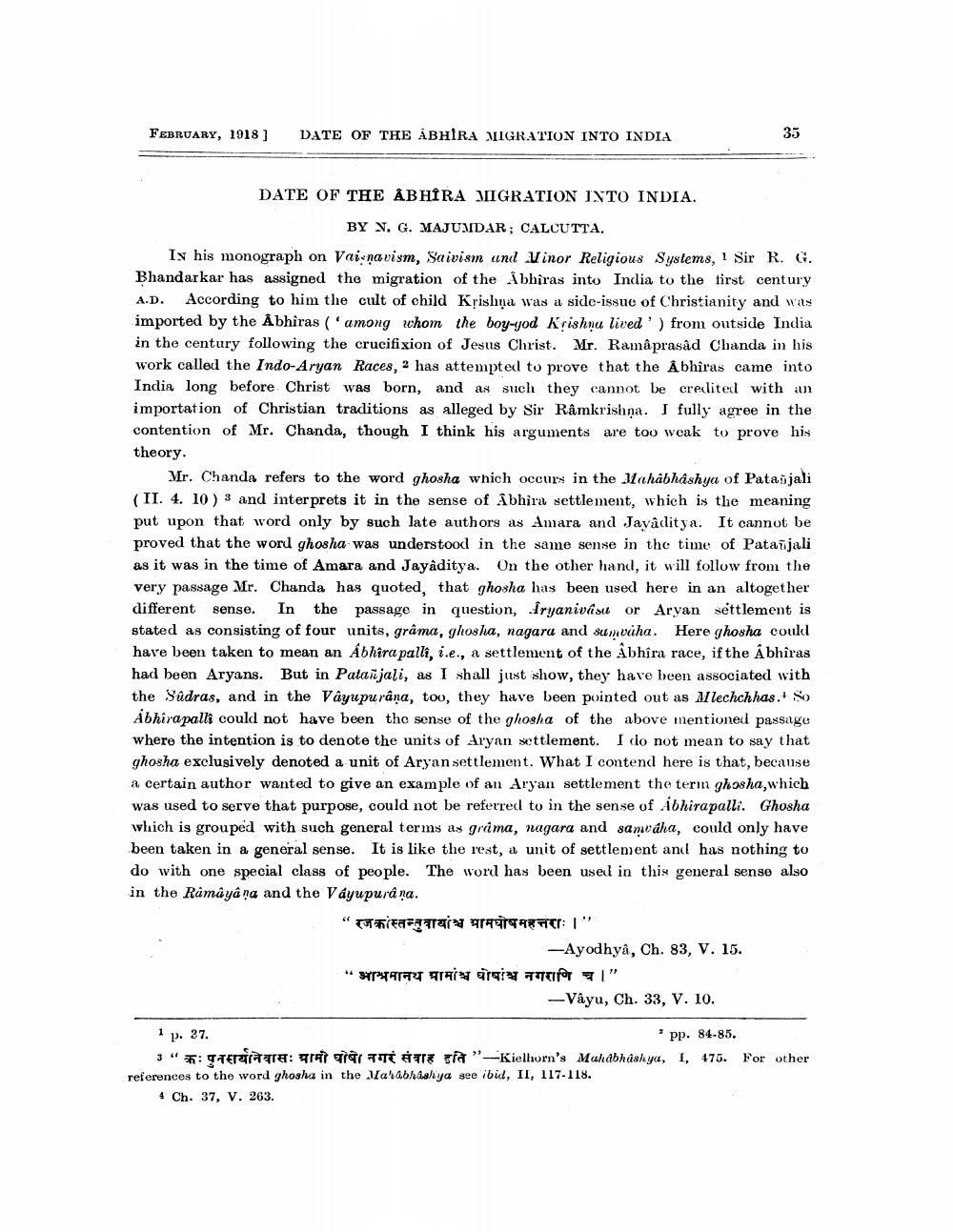________________
FEBRUARY, 1918
DATE OF THE ABHIRA MIGRATION INTO INDIA
35
DATE OF THE ABHIRA MIGRATION INTO INDIA.
BY N. G. MAJUMDAR; CALCUTTA, In his monograph on Vai navism, Saivism und Vinor Religious Systems, 1 Sir R. G. Bhandarkar has assigned the migration of the Abhiras into India to the first century A.D. According to him the cult of child Krishna was a side-issue of Christianity and was imported by the Abhiras (among whom the boy-yod Krishna lived' ) from outside India in the century following the crucifixion of Jesus Christ. Mr. Ramaprasad Chanda in his work called the Indo-Aryan Races, 2 has attempted to prove that the Abhiras came into India long before Christ was born, and as such they cannot be credited with an importation of Christian traditions as alleged by Sir Ramkrishna. I fully agree in the contention of Mr. Chanda, though I think his arguments are too weak to prove his theory.
Mr. Chanda refers to the word ghosha which occurs in the Mahabhåshya of Patañjali (II. 4. 10) 3 and interprets it in the sense of Abhira settlement, which is the meaning put upon that word only by such late authors as Amara and Jayaditya. It cannot be proved that the word ghosha was understood in the same sense in the time of Patanjali as it was in the time of Amara and Jayaditya. On the other hand, it will follow from the very passage Mr. Chanda has quoted, that ghosha has been used here in an altogether different sense. In the passage in question, Iryanivisu or Aryan settlement is stated as consisting of four units, grâma, ghosha, nagara and sumviha. Here ghosha could have been taken to mean an Abhirapalli, i.e., a settlement of the Abhira race, if the Abhiras had been Aryans. But in Patañjali, as I shall just show, they have been associated with the Sadras, and in the Vayupurâna, too, they have been pointed out as Mlechchhas. So Abhirapalli could not have been the sense of the ghosha of the above mentioned passage where the intention is to denote the units of Aryan settlement. I do not mean to say that ghosha exclusively denoted a unit of Aryan settlement. What I contend here is that, because a certain author wanted to give an example of an Aryan settlement the term ghosha,which was used to serve that purpose, could not be referred to in the sense of Abhirapalli. Ghosha which is grouped with such general terms as grama, nagara and samvdha, could only have been taken in a general sense. It is like the rest, a unit of settlement and has nothing to do with one special class of people. The word has been used in this general sense also in the Ramayana and the Vayupurd na. "T FT-ATTİN ATTARTTTT: 1"
-Ayodhyâ, Ch. 83, V. 15. " BATUT AN AU "
-Vâyu, Ch. 33, V. 10.
1 p. 37.
pp. 84-85. 3" TEST : raigar TTT 2 gia"-Kielhorn's Mahabhashya, I, 475. For other references to the word ghosha in the Mahabhashya see ibid, II, 117-118.
4 Ch. 37, V. 263.




